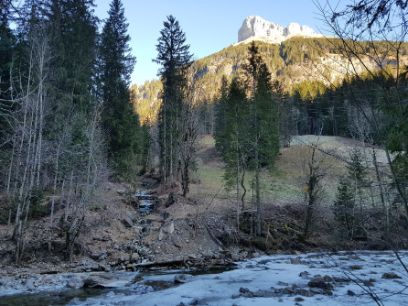- Research Project
Modelling tests of a mudslide in Upper Emmental
BFH researchers are analysing the impact of a mudslide in Upper Emmental using a realistic testing rig replicated on a scale of 1:30. The project seeks to develop measures to prevent a possible mudslide causing the nearby River Emme to burst its banks.
Factsheet
- Lead school(s) School of Architecture, Wood and Civil Engineering
- Institute Institute for Infrastructure and Environment IIU
- Duration (planned) 30.11.2020 - 30.11.2021
- Project management Dr. Jolanda Jenzer Althaus
- Head of project Dr. Jolanda Jenzer Althaus
-
Project staff
Gianluca Flepp
Armin Rist
Dirk Proske
Adel Albaba -
Partner
Geotest AG
Gemeinde Schangnau, OIK IV
Schwellenkooperation Schangnau - Keywords Mudslide, Upper Emmental, river engineering, modelling
Background
There have been two major mudslides in Upper Emmental since 2000. The damage caused has been manageable so far. The danger of mudslides is nevertheless particularly high during the warm, rainy summers. The Schangnau Flood Protection Agency wishes to be equipped to deal with a more severe mudslide in the event of bad weather in future which could cause the River Emme to burst its banks and lead to flooding.
Goals
Bern University of Applied Sciences is analysing how a mudslide in Upper Emmental might actually unfold. The aim is to develop measures to prevent the River Emme from bursting its banks in the event of a mudslide and to avoid flood damage to buildings and harm to people in the local area.
Procedure
A model rig is being used to test the impact of a mudslide in Upper Emmental at BFH’s Burgdorf Tiergarten site. The area at risk in Emmental was measured by students. A model was then replicated on a scale of 1:30 (4.5 m wide, 10 m long and around 2.5 m high).
The first of around 30 tests in total began in mid-December 2020. A mudslide of sand, gravel and water was dropped into the model trench. Researchers observed the behaviour of the mudslide, where it broke through the trench, how much debris was deposited in the neighbouring wood and how much ended up in the River Emme.
The research team led by Dr Jolanda Jenzer Althaus are recording the results using laser measuring devices and high-speed cameras and are documenting their observations. Further tests aim to develop measures to prevent too much mudslide debris being deposited in the River Emme. If too much debris ends up on the riverbed, the River Emme could overflow, causing flood damage to buildings and harm to people in the local area.
Results
The tests and modelling by GEOTEST AG have shown that the risk of flooding can be classified as low. Based on this finding, the hazard map could be adapted and no structural land protection measures such as retention or diversion of the mudslide are necessary.

Sponsor

